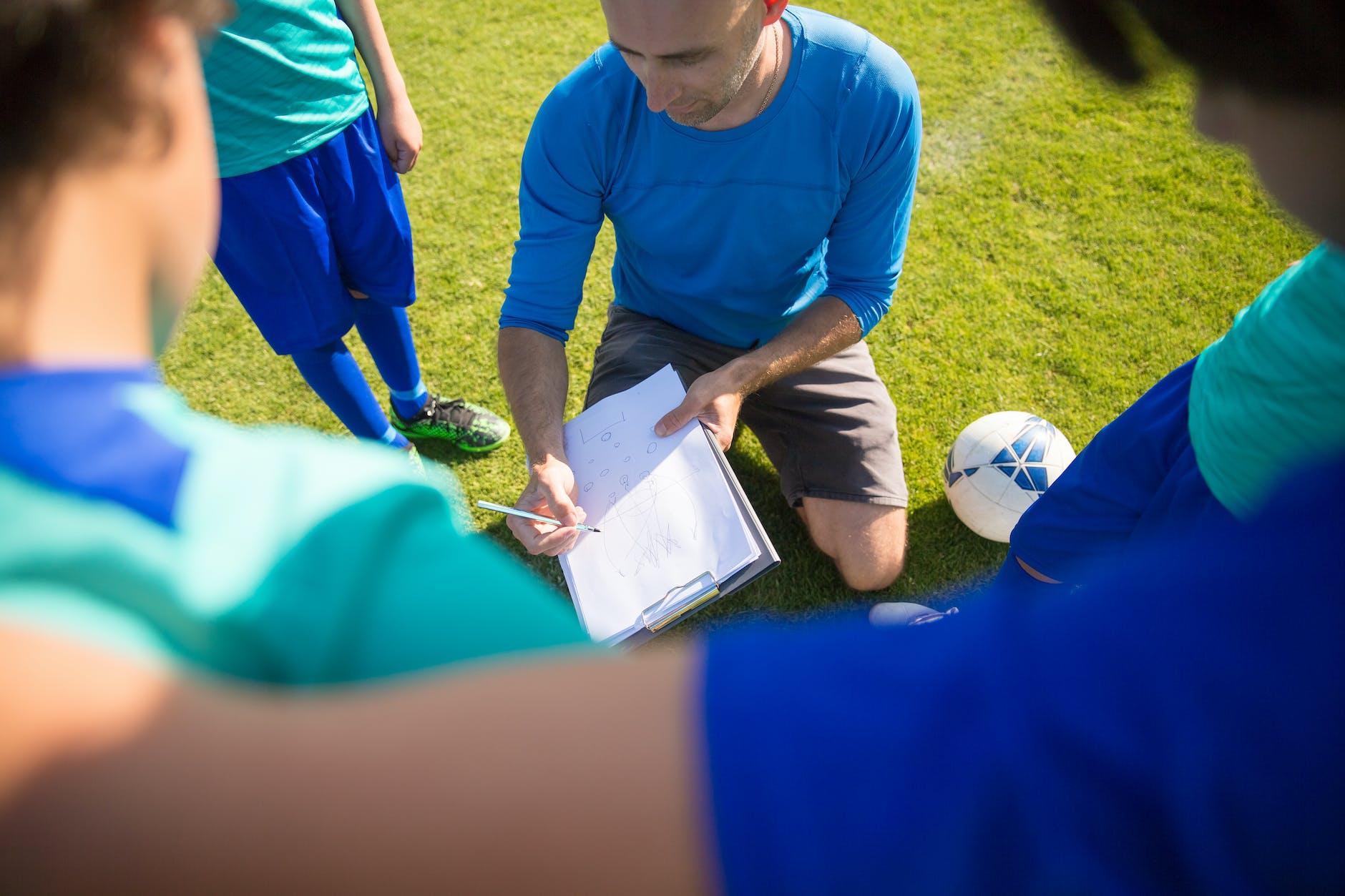Rondos are one of the best types of training for teams who want to play a possession and positional play style. The specific exercises have some basic characteristics that help the players to develop certain habits. Here I present the 4 best rondos that I personally used very often to train technical but also basic tactical fundamental principles and concepts. Use rondos to train and play like Pep Guardiola.
The list of the best rondos was created based on personal experience but also on a lot of hours studying the Positional Play style of the game and Guardiola’s training methodology. read our article on the most important pillars to implement a Positional Play style.
The great Xavi Hernandez was always fascinated with the use of Rondos. Check the video to hear Xavi talking about rondos.

Elevate Your Coaching Journey
Are you ready to take your coaching career to the next level? Look no further than FootballCoach365, your ultimate destination for top-notch coaching material.
Join the Coach’s Corner today and experience the transformative power of proper planning, training and coaching.
The 4 best rondos:
- The “simplest rondo” – 3 v 1
- The “classic” – 4 v 2
- Rondo with inside pivot – 6 v 3 + 1
- “Double Rondo” the rondo with motion – 5 v 3
Main Rondo’s Description
- Rondo is a type of drill focused on keeping the ball possession
- The coach can add many tactical and technical elements
- The main characteristic is the overload of the team in possession vs the defending team
- It is a continuous drill so it can be used also for physical conditioning purposes (changing the roles of the players by time and not when they recover the ball)
- The usual rule for points is to complete a number of passes
- Each rondo presented here can be trained with a different number of players
The main coaching points for all types of rondos are:
- Movement to support
- Receiving with the back foot
- Correct body profile
- Scan the space before receiving
- Positioning Understand 1st, 2nd, and 3rd line of passes
Rondo #1: The “simplest rondo” – 3 v 1

The player’s relationships are 3 v 1. Due to its high intensity, it is usually used for physical conditioning purposes.
For smaller ages (U10) it can be used as an introduction rondo to train the very basic attacking individual fundamentals like the offer support, passing quality, body profile, and receiving with the back foot.
Rondo’s rules a coach can use basically on age, level of ability, and objective of the day:
- Complete a set number of passes (i.e 6) for the defenders to stay inside even if they recover the ball
- Change after a set duration counting the number of passes/recoveries
Rondo #2: The “classic” – 4 v 2

The player’s relationships are 4 v 2. This is the most simple rondo to start adding more individual tactical elements. here the coach can train the different types of passing lines (1st, 2nd, and 3rd).
For smaller ages (U10) it can be used as an introduction rondo to train the very basic attacking collective fundamentals like creating an overload in certain areas, progressive passes (passes that splits defenders), possession to attract pressure, and communication.
Rondo’s rules a coach can use basically on age, level of ability, and objective of the day:
- Complete a set number of passes (i.e 6) for the defenders to stay inside even if they recover the ball
- Use different rules on touches (1 touch, 2 touches, 3 touches, obligatory two touches, alter between 1 and 2 touches etc.)
- Count immediately a point when a pass splits the defenders in two (enhance the 3rd passing line)
Rondo #3: Rondo with inside pivot – 6 v 3 + 1

The player’s relationships are 6 v 3 + 1 neutral. Here the focus is on the inside player who acts as a “pivot”. The exercise with silty different structure and rules can be also characterized as a Positional Game. For example, Guardiola uses a lot of the Positional Play football game 4 v 3 + 3 neutrals to train all his fundamental ideas.
The coach should train the inside player to always support in diagonal positions, find the free inside spaces, use limited touches and scan the area before receiving the ball.
Also, additionally, the coach can introduce the concept of the Third Man, a very important concept in Positional Play football.
The specific type of rondos should be used for older ages such as U12 and above (for that reason is was included in my list with the best rondos). The players are more mature to understand in better way the terms of time and space. The inside player will feel more comfortable playing between the lines and in tight spaces with lots of pressure.
Further to the basic individual and collective fundamentals that can be trained, with the inside player’s rondo, the additional tactical concept that can be trained is the intention to play outside in order to create space inside.
Rondo’s rules a coach can use basically on age, level of ability, and objective of the day:
- Complete a set number of passes (i.e 6) for the defenders to stay inside even if they recover the ball
- Use different rules on touches (1 touch, 2 touches, 3 touches, obligatory two touches, alter between 1 and 2 touches, etc.)
- Count immediately a point when a pass splits the defenders in two (enhance the 3rd passing line)
- If the inside player receives and passes to another outside player, a point is awarded immediately.
Rondo #4: “Double Rondo” the rondo with motion – 5 v 3

The double rondo type of rondos is used to add movement with or without the ball to the exercise.
It is also very good for physical condition purposes depending on the number of players involved and the size of the rondos.
Here the emphasis is to move the ball to the empty spaces after a pre-set number of passes or after the specific area is occupied by a specific number of opponents. This will represent the switch of play and the tactical intention of a team to search for less occupied spaces.
The specific type of rondos should be used for older ages such as U12 and above (for that reason it was also included in the list with the best rondos). The concepts of overload/underload spaces are easier to be understood for U12 ages and above. It can be used for smaller ages but only in a way to add motion and support the ball after a pass to a far player and not to apply the concept of continuously changing numerical superiorities.
Further to the basic individual and collective fundamentals that can be trained, as explained above, the concept of always supporting the ball after the pass can be introduced.
Rondo’s rules a coach can use basically on age, level of ability, and objective of the day:
- Complete a set number of passes (i.e 6) for the defenders to stay inside even if they recover the ball
- Use different rules on touches (1 touch, 2 touches, 3 touches, obligatory two touches, alter between 1 and 2 touches, etc.)
- Complete a minimum number of passes and transfer the ball to the other box
- Count double pass when a pass splits the defenders in two (enhance the 3rd passing line)
- Change boxes when more than 1 defender enters the ball area. This will increase the tempo of the game and the player’s awareness to understand when to switch play and when to keep the ball in the same area.
Like and subscribe to my Youtube channel
See below all the 4 best rondos in an animated form for a better understanding.
Conclusion for the best Rondos
Here I presented some of my favorite rondos. I considered them as the best rondos a coach can use to train the most important basic fundamental (mainly the attacking ones) of football. The choice was purely subjective and based on my personal experience.
The main key point a coach must have in mind is to always change the number of players, rules, pitch’s size, and drill objectives in order to keep the player’s motivation high but always have in mind what he/she will train.
The specific list with the best Rondos is a guide for every coach to use to design his own drills based on his team’s characteristics, player level, and his own game model.
Your feedback is always welcome. Please leave your comment on your personal best rondos.

